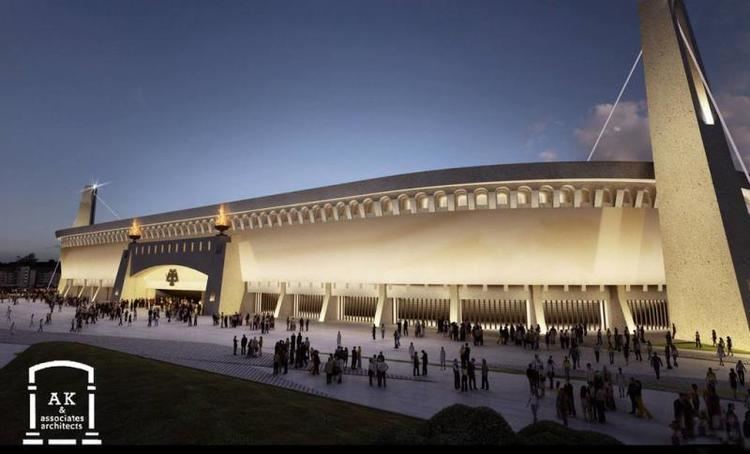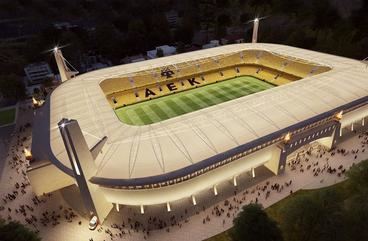Operator Dikefalos 1924 S.A Surface Grass Owner A.E.K. Executive suites 40 | Capacity 31.527 Scoreboard 2 Construction cost 65 million EUR | |
 | ||
Full name Centre of Sports, Memory and Culture "Hagia Sophia" Location Nea Filadelfeia, Athens, Greece Similar Nikos Goumas Stadium, Ano Liosia Olympic Hall, Galatsi Olympic Hall, Athens Olympic Stadium, OACA Olympic Indoor Hall | ||
Haghia Sophia Stadium (Greek: Στάδιο Αγία Σοφία) is a planned football stadium in Nea Filadelfeia, a northwestern suburb of Athens, Greece for AEK Athens F.C. The stadium will be built at exactly the same location where the legendary home ground of AEK Athens F.C., Nikos Goumas Stadium was situated.
Contents

Name

The stadium will be named after the Greek Cathedral at Istanbul, Hagia Sophia. A commercial name will also be given to the stadium.
History

In 1926, land in Nea Filadelfeia that was originally set aside for refugee housing was donated as a training ground for the Greek refugees. A stadium was built at the site in 1930, named "Nikos Goumas", and became the home ground of AEK Athens FC.

Giannis Granitsas, President of A.E.K. (sports club) at the time, decided to demolish the stadium in June 2003, to build a new stadium at Nea Filadelfeia, as he claimed that the stadium was seriously damaged from the 1999 Athens earthquake. His plan was to build a new stadium at the same site, which would include also a basketball indoor hall and a mall. The goal was for the stadium to be ready until the 2004 Summer Olympics.

However, shortly after the construction of the new stadium were halted by the Council of State, which decided that the construction plans of the stadium were contrary to the Constitution of Greece.

In 2005, Dimitris Melissanidis was a candidate for the presidency of Amateur A.E.K, and presented a plan for the construction of a stadium at the area of Nikos Goumas, bearing the name Hagia Sophia. However, he lost the elections.
In 2007 AEK Athens F.C. president Demis Nikolaidis was developing a project to build a stadium at Ano Losia. The plan was cancelled due to lack of funds.
After the bankruptcy and relegation of AEK Athens F.C in 2013, Dimitris Melissanidis took up the reorganization of the club and recovered the plan of Hagia Sophia in a press conference held at 10 July 2013.
The first presentation of the stadium took place on 2 of October 2013 in the Miltos Kountouras hall at the Nea Filadelfia High School. The project manager of the stadium Dimitris Andriopoulos announced the first features and facilities. The stadium will fulfill the criteria to be a four star in the UEFA stadium categories, it will have capacity of 32,000 - 34,000 and will have 40 suites. There will be a museum about the Greek refugees who left from Asia Minor in 1922 . It will offer 1500 - 2000 jobs during its construction and 250 - 400 permanent jobs when it will be constructed. The stadium's construction is expected to begin in 2014 and finish by 2015. The first images of the stadium were also exposed. The stadium is designed after the Walls of Constantinople where the club is originated from, and it will resemble a castle from the outside.
The grand presentation of the stadium took place on 6 of November 2013 at the Onassis Cultural Center in Athens, which will contribute financially to the construction of the stadium. A symbolic fund was also donated by the Ecumenical Patriarchate of Constantinople. Technical information about the stadium were presented and its facilities were illustrated in a 20-minute video.
On 2 January 2015, the municipality of Filadelfeia-Chalkidona filed a complaint at the Council of State against the decision of the management of forests of afministration of Athens, that allocates 6 acres from the Grove of Nea Filadelfeia. Also, 17 citizens of the municipality of Filadelfeia-Chalkidona filed a complaint on 1 December 2014 about the same matter.
The case was heard at the Council of State on 6 March 2015. The decision was issued on 5 June 2015, and it rejected the claims of the municipality and the citizens as unsubstansive and obscure.
The plan for the building of the stadium was released in public consultation by the Ministry of Productive Reconstruction, Environment and Energy on 22 July. The process would be completed in 45 days. The municipality of Filadelfeia - Chalkidona filed an application for an extension of the public consultation for an extra 45 days, which was accepted. The consultation was finally concluded on 24 November 2015.
On 28 January 2016, the meeting of the Administrative Regiοn of Attica approved the Study of Environmental Impact of the project.
The minister of Environment and Energy Panos Skourletis signed the Study of Environmental impact of the stadium on 31 March 2016.
Funding
The construction cost is eastimated around € 65,000,000. The funding will be completed in three stages. The first phase of construction will cost € 25,900,000, the second phase € 20,000,000 and the third € 14,600,000. The Administrative region of Attica will fund the stadium with € 20,000,000. The sum left will be funded by Dikefalos A.E, a company that was founded for the construction of the stadium.
Facilities
In the video presented on the 6th of November, the following facilities were exhibited:
